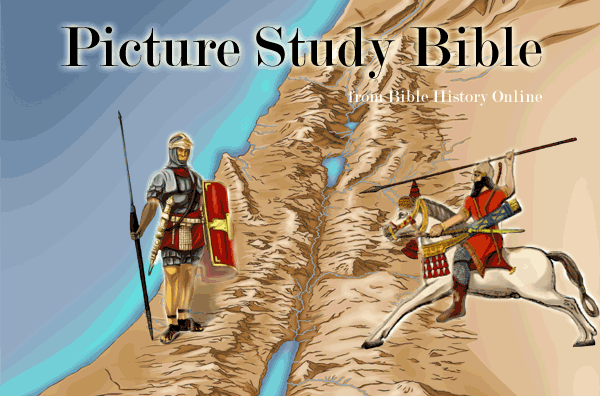Daniel 3:1 Nebuchadnezzar the king made an image of gold, whose height was threescore cubits, and the breadth thereof six cubits: he set it up in the plain of Dura, in the province of Babylon. - Free Bible Online
Daniel 3:1 Nebuchadnezzar the king made an image of gold, the height of which [was] sixty cubits [and] its width six cubits; he set it up on the plain of Dura in the province of Babylon.
Da 3:1-30. NEBUCHADNEZZAR'S IDOLATROUS IMAGE; SHADRACH, MESHACH, AND ABED-NEGO ARE DELIVERED FROM THE FURNACE.
Between the vision of Nebuchadnezzar in the second chapter and that of Daniel in the seventh, four narratives of Daniel's and his friends' personal history are introduced. As the second and seventh chapters go together, so the third and sixth chapters (the deliverance from the lions' den), and the fourth and fifth chapters. Of these last two pairs, the former shows God's nearness to save His saints when faithful to Him, at the very time they seem to be crushed by the world power. The second pair shows, in the case of the two kings of the first monarchy, how God can suddenly humble the world power in the height of its insolence. The latter advances from mere self-glorification, in the fourth chapter, to open opposition to God in the fifth. Nebuchadnezzar demands homage to be paid to his image (Da 3:1-6), and boasts of his power (Da 4:1-18). But Belshazzar goes further, blaspheming God by polluting His holy vessels. There is a similar progression in the conduct of God's people. Shadrach, Meshach, and Abed-nego refuse positive homage to the image of the world power (Da 3:12); Daniel will not yield it even a negative homage, by omitting for a time the worship of God (Da 6:10). Jehovah's power manifested for the saints against the world in individual histories (the third through sixth chapters) is exhibited in the second and seventh chapters, in world-wide prophetical pictures; the former heightening the effect of the latter. The miracles wrought in behalf of Daniel and his friends were a manifestation of God's glory in Daniel's person, as the representative of the theocracy before the Babylonian king, who deemed himself almighty, at a time when God could not manifest it in His people as a body. They tended also to secure, by their impressive character, that respect for the covenant-people on the part of the heathen powers which issued in Cyrus' decree, not only restoring the Jews, but ascribing honor to the God of heaven, and commanding the building of the temple (Ezr 1:1-4) [AUBERLEN].
1. image--Nebuchadnezzar's confession of God did not prevent him being a worshipper of idols, besides. Ancient idolaters thought that each nation had its own gods, and that, in addition to these, foreign gods might be worshipped. The Jewish religion was the only exclusive one that claimed all homage for Jehovah as the only true God. Men will in times of trouble confess God, if they are allowed to retain their favorite heart-idols. The image was that of Bel, the Babylonian tutelary god; or rather, Nebuchadnezzar himself, the personification and representative of the Babylonian empire, as suggested to him by the dream (Da 2:38), "Thou art this head of gold." The interval between the dream and the event here was about nineteen years. Nebuchadnezzar had just returned from finishing the Jewish and Syrian wars, the spoils of which would furnish the means of rearing such a colossal statue [PRIDEAUX]. The colossal size makes it likely that the frame was wood, overlaid with gold. The "height," sixty cubits, is so out of proportion with the "breadth," exceeding it ten times, that it seems best to suppose the thickness from breast to back to be intended, which is exactly the right proportion of a well-formed man [AUGUSTINE, The City of God, 15.26]. PRIDEAUX thinks the sixty cubits refer to the image and pedestal together, the image being twenty-seven cubits high, or forty feet, the pedestal thirty-three cubits, or fifty feet. HERODOTUS [1.183] confirms this by mentioning a similar image, forty feet high, in the temple of Belus at Babylon. It was not the same image, for the one here was on the plain of Dura, not in the city.
JFB.
Questions Related to this Verse
Where in Scripture does it mention The plain of Dura?Select a Chapter
-
Daniel 1 |
Daniel 2 |
Daniel 3 |
Daniel 4 |
Daniel 5 |
Daniel 6 |
Daniel 7 |
Daniel 8 |
Daniel 9 |
Daniel 10 |
Daniel 11 |
Daniel 12 |
Select a Book of the Bible
-
Genesis |
Exodus |
Leviticus |
Numbers |
Deuteronomy |
Joshua |
Judges |
Ruth |
1 Samuel |
2 Samuel |
1 Kings |
2 Kings |
1 Chronicles |
2 Chronicles |
Ezra |
Nehemiah |
Esther |
Job |
Psalms |
Proverbs |
Ecclesiastes |
Song of Solomon |
Isaiah |
Jeremiah |
Lamentations |
Ezekiel |
Daniel |
Hosea |
Joel |
Amos |
Obadiah |
Jonah |
Micah |
Nahum |
Habakkuk |
Zephaniah |
Haggai |
Zechariah |
Malachi |
Matthew |
Mark |
Luke |
John |
Acts |
Romans |
1 Corinthians |
2 Corinthians |
Galatians |
Ephesians |
Philippians |
Colossians |
1 Thessalonians |
2 Thessalonians |
1 Timothy |
2 Timothy |
Titus |
Philemon |
Hebrews |
James |
1 Peter |
2 Peter |
1 John |
2 John |
3 John |
Jude |
Revelation |
The Book of Daniel
Daniel 6:15-16 - Then these men assembled unto the king, and said unto the king, Know, O king, that the law of the Medes and Persians [is], That no decree nor statute which the king establisheth may be changed. Then the king commanded, and they brought Daniel, and cast [him] into the den of lions. [Now] the king spake and said unto Daniel, Thy God whom thou servest continually, he will deliver thee.
Daniel 7:13-14 - I saw in the night visions, and, behold, [one] like the Son of man came with the clouds of heaven, and came to the Ancient of days, and they brought him near before him. And there was given him dominion, and glory, and a kingdom, that all people, nations, and languages, should serve him: his dominion [is] an everlasting dominion, which shall not pass away, and his kingdom [that] which shall not be destroyed.
Daniel 9:24-27 - Seventy weeks are determined upon thy people and upon thy holy city, to finish the transgression, and to make an end of sins, and to make reconciliation for iniquity, and to bring in everlasting righteousness, and to seal up the vision and prophecy, and to anoint the most Holy. Know therefore and understand, [that] from the going forth of the commandment to restore and to build Jerusalem unto the Messiah the Prince [shall be] seven weeks, and threescore and two weeks: the street shall be built again, and the wall, even in troublous times. And after threescore and two weeks shall Messiah be cut off, but not for himself: and the people of the prince that shall come shall destroy the city and the sanctuary; and the end thereof [shall be] with a flood, and unto the end of the war desolations are determined. And he shall confirm the covenant with many for one week: and in the midst of the week he shall cause the sacrifice and the oblation to cease, and for the overspreading of abominations he shall make [it] desolate, even until the consummation, and that determined shall be poured upon the desolate.
The Old Testament - A Brief Overview
Bible Survey - Daniel
Hebrew Name - Dani-El "God is my judge"
Greek Name - Danil (Greek form of the Hebrew)
Author - Daniel (According to Tradition)
Date - 607 BC Approximately
Theme - The final kingdom of the Messiah
Types and Shadows - In Daniel Jesus was the fourth man in the fiery furnace
The prophet Daniel was actually taken captive during the Babylonian invasion on Jerusalem, the first attack in 607 BC. When Daniel came to Babylon he became a chief minister at Nebuchadnezzar's royal court. He became known as a man who could interpret dreams and visions. God did mighty miracles through Daniel that impressed King Nebuchadnezzar himself, so much so that he worshiped the Jewish God. Later when the Medes and Persians conquered Babylon King Cyrus ruled the Persian Empire. He also had visions that Daniel had given interpretation to. some of the great miracles mentioned in the Bible happened in the book of Daniel: the fiery furnace, the handwriting on the wall, and Daniel in the lion's den. Daniel can be seen in the Bible as the Empire predicting prophet, because he accurately predicted the world governing empires before they came on the scene, first Babylon, second Persia, third Greece, fourth Rome, and in the last days would be another Roman empire where the antichrist would arise. At this time the Messiah will return and set up his everlasting kingdom. Daniel also predicted the exact day and year the Messiah would die. There is also a prophecy Daniel refers to as the 70th week, which speaks of a seven-year period in the future that will mark the second coming of the Messiah (Son of Man) coming with the clouds of heaven. - The above text is © Rusty Russell - Bible History Online and must be sourced for use on a website.
"I was watching in the night visions, and behold, One like the Son of Man, coming with the clouds of heaven! He came to the Ancient of Days, and they brought Him near before Him. Then to Him was given dominion and glory and a kingdom, that all peoples, nations, and languages should serve Him. His dominion is an everlasting dominion, which shall not pass away, and His kingdom the one which shall not be destroyed." Daniel 7:13-14
Daniel was among the Jewish captives who were brought to Babylon from Jerusalem after Nebuchadnezzar conquered the city. Daniel was still a youth but apparently of high status (Daniel 1:3). He was of such a high status that he was considered one of the wise men of the court of Babylon .He was quickly recognized in Babylon for his devotion to the one God Yahweh, and he refused to eat of the "dainties" which were brought to him by the king's servants. He also became recognized as the interpreter of dreams (Daniel 1:8-16), because when King Nebuchadnezzar being disturbed by a dream asked his own wise men to interpret they could not. Daniel offered to give the king the interpretation and the King was very appreciative to Daniel, he was so impressed that he allowed Daniel to rise to a place of great prominence in Babylon. Later when Babylon fell to the Persians the Jews had new masters over them, and Daniel was quickly recognized as a very special man and he had favor with the king of Persia. This caused many of those in authority to scrutinize Daniel and to look for flaws in his character and they could not find any. They developed a plot which forced the King to have Daniel thrown in the lion's den. The King recognizing their treachery and hoped for Daniel's deliverance, and when the Lord saved Daniel from the mouth of the lions Darius ordered his own leaders to be thrown into the lion's den and they were torn in pieces immediately.
Daniel the Empire Predicting Prophet
Daniel is clearly seen as the Empire predicting prophet. He was an interpreter of dreams, and God revealed through his interpretations his plans for the kingdoms that would rise to power in world history. At that time Babylon was in power, and in fact a world governing Empire in the ancient world. But Daniel said that Babylon would be defeated by the Medes and the Persians who would become a world governing empire. Then Greece would come and dominate the world, and after Greece the Romans would become a world governing empire. Then Daniel predicted that way in the future a final world governing empire would rise that would be like Rome, but different in that it would consist of 10 kings, and then finally 1 king who would rise to power. This 1 king would be a man referred to in the Bible as the antichrist. This would all take place in the final seven-year period known as the 70th week of Daniel. At its consummation the Lord will return, he will crush the enemy, and he will set up a kingdom, an everlasting kingdom, which will never be destroyed.
The 70 weeks of Daniel
The 70 weeks in Daniel are mentioned in Daniel 9, and they refer to a prophecy of Daniel where he claims that the king of Persia will release the Jews to rebuild their Temple in Jerusalem. When he makes this decree the Jews are to begin counting, and after 70 weeks (7 year periods or 490 years) the kingdom of the Messiah will be established on earth. But something interesting would happen, at the end of the 69th week (483 years) the Messiah will be "cut off" which indicates His death. The final seven year period is suddenly thrown into the future, to the time of the end of the world. This final seven year period is described in the book of Revelation as a time of the Messiah taking back the earth. It is divided into two 3 1/2 year periods and directly in the middle is when the antichrist sets up his throne in Jerusalem and reveals himself as God. Certain portions of this final seven years are mentioned in other prophetic books of the Bible like Zechariah.
Daniel, The Author of His Book
Daniel was the author of this book, and this was confirmed by Jesus himself, but there has been considerable criticism about the book of Daniel because of the accuracy of the prophecies. Many claim that these had to been written after the fact, and that Daniel could not possibly have known so much detail about the future. The first major critic of the genuineness of the book of Daniel was Porphyry of Tyre, a Greek philosopher of the third century AD who claimed that the book of Daniel had been written by a person living in the second century BC during the reign of Antiochus Epiphanes. His main reason for rejecting the book of Daniel was centered around the person of Antiochus Epiphanes, whom Daniel claimed was a prototype of the Antichrist. Daniel's prophecies written a few hundred years prior but were very very accurate in their detail. Many other critics have tried to discredit the book of Daniel, but the Bible and history have confirmed that Daniel was the author of this book, and therefore was written at the time of the Persian Empire (sixth century BC).
The contents of the book may be analyzed further as follows :
Outline of the Book of Daniel
Daniel is divided into two sections of six chapters each. Daniel 1-6 are largely historical, explaining how Daniel came to be in the court of Nebuchadnezzar and of his rise to power. It tells of Nebuchadnezzar's dream of the image which Daniel interpreted to refer to the current kingdom and three world powers which would arise after it and of the kingdom of God "a kingdom which shall never be destroyed" which would arise during the era of the last of these great empires. This section also includes the account of the deliverance of Shadrach, Meshach, and Abednego from the fiery furnace and of the handwriting on the wall which spelled out the defeat of Belshazzar at the hands of the Medes and the Persians.
The second section, Daniel 8-12, describes visions which Daniel received concerning the great world powers of the future and the kingdom of God.
The Greek translation of Daniel contains additions not found in the Hebrew and Aramaic text. These additions are found as separate books in the Apocrypha and are called The Song of the Three Holy Children, the History of Susanna, and Bel and the Dragon.
The book of Daniel assures God's people that their situation in exile would not be permanent, that God would keep his promise to Abraham, he would keep his promise through Jeremiah the prophet that they would return after 70 years. And he would also keep his promise that the Jews would still be the channel through which all nations would be blessed. The book of Daniel is a grand tribute to the providence of God and His lordship of history and the universe.
Daniel Resources
The Divided Kingdom
The
Northern Kingdom of Israel
The
Southern Kingdom of Judah
The Assyrian Captivity
The Babylonian Captivity
The Return From Babylon
The Prophets
The Messiah
The Book of Daniel
More About the Book of
Daniel
Daniel in the Picture
Study Bible
Timeline of the Ancient
World
Back to the Old Testament
Back to Bible
History Online
Bibliography Information
Free Bible Online Picture Study Bible, King James Version. New York: American Bible Society: www.free-bible.com, 1995-2013. Bible History Picture Study Bible. May 11, 2024.
- King James Bible Home
- Free Bible Home Page
- Bible Encyclopedia (ISBE)
- Online Bible (KJV)
- Naves Topical Bible
- Smith's Bible Dictionary
- Easton's Bible Dictionary
- Fausset's Bible Dictionary
- Matthew Henry Bible Commentary
- Hitchcock's Bible Dictionary
Read The Bible
- 1599 Geneva Bible (GNV)
- 21st Century King James Version (KJ21)
- American Standard Version (ASV)
- Amplified Bible (AMP)
- Amplified Bible, Classic Edition (AMPC)
- Authorized (King James) Version (AKJV)
- BRG Bible (BRG)
- Christian Standard Bible (CSB)
- Common English Bible (CEB)
- Complete Jewish Bible (CJB)
- Contemporary English Version (CEV)
- Darby Translation (DARBY)
- Disciples’ Literal New Testament (DLNT)
- Douay-Rheims 1899 American Edition (DRA)
- Easy-to-Read Version (ERV)
- English Standard Version (ESV)
- English Standard Version Anglicised (ESVUK)
- Evangelical Heritage Version (EHV)
- Expanded Bible (EXB)
- GOD’S WORD Translation (GW)
- Good News Translation (GNT)
- Holman Christian Standard Bible (HCSB)
- International Children’s Bible (ICB)
- International Standard Version (ISV)
- J.B. Phillips New Testament (PHILLIPS)
- Jubilee Bible 2000 (JUB)
- King James Version (KJV)
- Lexham English Bible (LEB)
- Living Bible (TLB)
- Modern English Version (MEV)
- Mounce Reverse Interlinear New Testament (MOUNCE)
- Names of God Bible (NOG)
- New American Bible (Revised Edition) (NABRE)
- New American Standard Bible (NASB)
- New American Standard Bible 1995 (NASB1995)
- New Catholic Bible (NCB)
- New Century Version (NCV)
- New English Translation (NET)
- New International Reader's Version (NIRV)
- New International Version - UK (NIVUK)
- New International Version (NIV)
- New King James Version (NKJV)
- New Life Version (NLV)
- New Living Translation (NLT)
- New Matthew Bible (NMB)
- New Revised Standard Version (NRSV)
- New Revised Standard Version Catholic Edition (NRSVCE)
- New Revised Standard Version, Anglicised (NRSVA)
- New Revised Standard Version, Anglicised Catholic Edition (NRSVACE)
- New Testament for Everyone (NTE)
- Orthodox Jewish Bible (OJB)
- Revised Geneva Translation (RGT)
- Revised Standard Version (RSV)
- Revised Standard Version Catholic Edition (RSVCE)
- The Message (MSG)
- The Voice (VOICE)
- Tree of Life Version (TLV)
- World English Bible (WEB)
- Worldwide English (New Testament) (WE)
- Wycliffe Bible (WYC)
- Young's Literal Translation (YLT)
Table of Contents
Main Menu
- Ancient Assyrian Social Structure
- Ancient Babylonia
- Ancient Canaan During the Time of Joshua
- Ancient History Timeline
- Ancient Oil Lamps
- Antonia Fortress
- Archaeology of Ancient Assyria
- Assyria and Bible Prophecy
- Augustus Caesar
- Background Bible Study
- Bible
- Biblical Geography
- Fallen Empires - Archaeological Discoveries and the Bible
- First Century Jerusalem
- Glossary of Latin Words
- Herod Agrippa I
- Herod Antipas
- Herod the Great
- Herod's Temple
- High Priest's in New Testament Times
- Jewish Literature in New Testament Times
- Library collection
- Map of David's Kingdom
- Map of the Divided Kingdom - Israel and Judah
- Map of the Ministry of Jesus
- Matthew Henry Bible Commentary
- Messianic Prophecy
- Nero Caesar Emperor
- Online Bible Maps
- Paul's First Missionary Journey
- Paul's Second Missionary Journey
- Paul's Third Missionary Journey
- Pontius Pilate
- Questions About the Ancient World
- Tabernacle of Ancient Israel
- Tax Collectors in New Testament Times
- The Babylonian Captivity
- The Black Obelisk of Shalmaneser
- The Books of the New Testament
- The Court of the Gentiles
- The Court of the Women in the Temple
- The Destruction of Israel
- The Fall of Judah with Map
- The History Of Rome
- The Incredible Bible
- The Jewish Calendar in Ancient Hebrew History
- The Life of Jesus in Chronological Order
- The Life of Jesus in Harmony
- The Names of God
- The New Testament
- The Old Testament
- The Passion of the Christ
- The Pharisees
- The Sacred Year of Israel in New Testament Times
- The Samaritans
- The Scribes
Ancient Questions
- How did the ancient Greeks and Romans practice medicine and treat illnesses?
- What were the major contributions of ancient Babylon to mathematics and astronomy?
- How did the ancient Persians create and administer their vast empire?
- What were the cultural and artistic achievements of ancient India, particularly during the Gupta Empire?
- How did ancient civilizations like the Incas and Aztecs build their remarkable cities and structures?
- What were the major trade routes and trading practices of the ancient world?
- What was the role of slavery in ancient societies like Rome and Greece?
- How did the ancient Mayans develop their sophisticated calendar system?
- What were the key events and significance of the Battle of Thermopylae in ancient Greece?
- What was life like for women in ancient Rome?
Bible Study Questions
- What does biblical archaeologist said about hieroglyphics?
- Where is the Negev where Abram went to in Genesis?
- What is the name of Ramallah in the Bible?
- How do we approach and study the historical and cultural context of biblical passages?
- What is the significance of the Psalms in personal and corporate worship?
- How do we discern and apply biblical principles to contemporary ethical issues?
- What is the biblical perspective on the nature of God's love and mercy?
- How do we interpret and understand apocalyptic literature in the Bible?
- What are the different covenants in the Bible and their significance?
- How do we grow in spiritual maturity and develop a deeper understanding of the Word?
About
Welcome to Free Bible: Unearthing the Past, Illuminating the Present! Step into a world where ancient history and biblical narratives intertwine, inviting you to explore the rich tapestry of human civilization.
Discover the captivating stories of forgotten empires, delve into the customs and cultures of our ancestors, and witness the remarkable findings unearthed by dedicated archaeologists.
Immerse yourself in a treasure trove of knowledge, where the past comes alive and illuminates our understanding of the present.
Join us on this extraordinary journey through time, where curiosity is rewarded and ancient mysteries await your exploration.
Recent posts
-

Personalized Baby Bibs for every Little
Every little one deserves to feel cherished and celebrated from the very start. These custom baby bibs, lovingly personalized with care, make the perf... -

The Art of Custom Home Design: Unveiling Wellcore Corporation's Expertise
In the ever-evolving panorama of contemporary production, customization reigns ultimate as a testament to innovation and the preference for a without ... -

Birthstones: A Sparkling Symphony of History, Symbolism, and Self-Expression
Birthstones, the ones fascinating gems linked to our delivery month, boast a records as rich and multifaceted because the jewels themselves. Their tal... -

The use of medicinal mushrooms by different religions of the world.
The integration of medicinal mushrooms into various religious practices around the world is a fascinating testament to their revered status across cul... -

Explore a Collection of Religious SVGs
Religious SVGs are versatile design elements that can be used to create a variety of personalized and meaningful projects. Whether you're looking to e...

